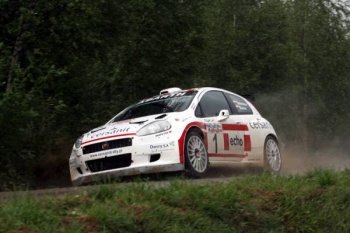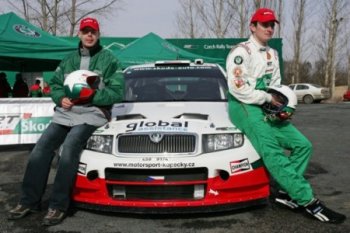 |
With four important rally titles already to
its name the Grande Punto Abarth S200 is
becoming a firm favourite choice with
privateer rally drivers. Here Michał Sołowow
pilots the Cersanit Rally Team's example
last year in Poland. |
|
|
 |
The Champion and Fila-sponsored Grande Punto
Abarth S2000 will be piloted in México later
this month by rapid Czech privateer Jan
Kopecký, who has been a familiar sight on
the FIA World Rally Championship scene for
some years. |
|
|
 |
Jan Kopecký (right) is most closely
associated with the Škoda brand having
driven on occasions for the factory and
Czech national teams since 2002. |
|
|
|
The
Super2000 Grande Punto Abarth will make its first trip
across the Atlantic to the Americas at the end of this
month when it will take part in the third round of the
2008 FIA World Rally Championship, the Corona México
Rally, which gets underway on 29th February.
The Grande Punto
Abarth S2000 will be piloted on this occasion by rapid Czech
privateer Jan Kopecký,
with co-driver
Petr Starý alongside, who has been a familiar sight on the
FIA World Rally Championship scene for some years. The car
will be run by Motorsport Kopecký while sponsorship will
come from Champion, Shell and Fila. After
starting life as a touring car driver he switched
disciplines at the beginning of the decade and has since
carved himself out a successful rally career.
Kopecký is most
closely associated with the Škoda brand having driven on
occasions for the factory and Czech national teams since
2002; most recently driving for the works-supported Czech
Republic Škoda Team at the wheel of the Fabia WRC on the
world stage last year where he eventually finished 12th in
the drivers' championship.
The 26-year-old also has a string
of FIA European Rally Championship wins and podium finishes
to his name, as well as a Czech national title, and he will
arrive in Mexico with a mass of experience, having now
contested more than thirty WRC events since his debut on the
competitive world championship scene on the Deutschland
Rally six years ago.
A late inclusion
into the calendar, overall route of the 2008 Corona México
Rally will be mostly unchanged for this edition except for
Day 1 where the last kilometres of Ortega and El Cubilete
stages have been re-routed for logistical reasons. These
changes help the effort to offer the most compact route in
WRC history. The total rally distance is 10 kilometres
shorter than 2007 (839 kilometres) and the liaisons will be
faster and use better quality roads. This is achieved while
keeping the competitive distance right below the maximum
allowed by the regulations at 357 kilometres. As always, all
the rally action will be centred in the vibrant city of
Leon, where all the activities are concentrated in the
Poliforum Leon. With more than a million and a half
inhabitants, Leon is one of the largest cities hosting a WRC
event.
Kopecký will be
looking for GpN class victory in the Grande Punto Abarth
(the compliant class for Super2000 machines on the WRC) in
México and is seeded on the official entry list as the top
runner in the category, at #61. His biggest challenge for
honours is likely to comes from the turbocharged GpN cars of
Benito Guerra (Mitsubishi Evo VIII) and Spiros Pavlides
(Subaru Impreza N4) in the 19-strong GpN entry list that
includes 9 Peugeots, 6 Mitsubishis, 2 Renaults and a single
Subaru, as well as the Super2000 Grande Punto Abarth. At the
front of the field in México overall rally victory will be
fought out between the factory Citroën, Ford, Suzuki and
Subaru outfits.
Corona Rally México
Rally America, today known as Corona Rally México, was
created in 1979 through a spirit of co-operation by the two
largest clubs in México; Club Automovilístico Francés de
México (CAF) and the Rally Automovil Club (RAC). It was
originally hosted in the State of México and ran
continuously until 1985. After an absence of six years, the
event then ran again in 1991 and followed the route of El
Paso de Cortes, between two of México’s largest volcanoes.
CAF then opted for a different concept; a short rally with a
high percentage of special stages. This event in 1993 was
held in Valle de Bravo under the direction of Gilles
Spitalier and was awarded the title ‘Rally of the Year’ by
the National Rally Commission.
The event
organizing committee then took over the running of the Rally
de las 24 Horas, the CAF’s flagship event, and, for this
reason, Rally America was not staged again until 1996, when
the internationalization of the project began. The CAF moved
the event to the US border in Ensenada, Baja California, for
two years where it started to amass international
recognition.
In 1998, the
organizers decided to rename the event and move it to León,
Guanajuato. With a long-term business plan focusing on
inclusion in the FIA World Rally Championship in place, the
event ran again in 1999 and 2000, stepping up a gear each
year. From 2001 to 2003, the organizers went for observation
by the FIA, successfully running the event on each occasion.
The 2003 Corona
Rally México - the 17th in the history of the rally - proved
to be the crucial turning point. New facilities at the
Poliforum Expo Center were groundbreaking in the sport and
this, combined with one of the most compact routes ever, put
the event firmly in the frame for World Championship status.
A total of 45 crews representing 11 countries crossed the
start ramp during one of the most spectacular opening
ceremonies seen in the sport.
Corona Rally
México made its debut in the expanded 16-round FIA World
Rally Championship in 2004, running successfully as the
third round of the series. Since 2005, the event has been
set as the first full gravel event of the season. For the
first time in their series, the FIA Junior World Rally
Championship contenders ventured outside Europe to come to
México in 2005.
The overall
route in 2007 became the shortest in WRC history, with less
than 850 Kilometres in overall length, thanks to the
compactness of the Rally footprint in the mountainous region
north of Leon. Notwithstanding this record, this short
overall route was achieved recording the maximum stage
distance allowed in the WRC regulations (360 Km) obtaining a
staggering 43% road section to special stage ratio.
|